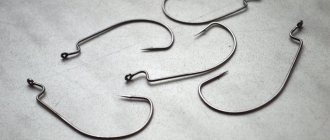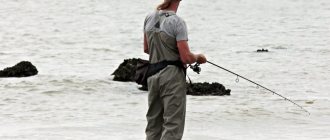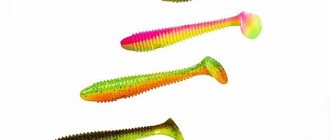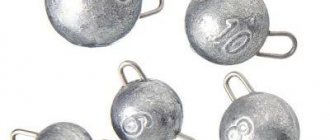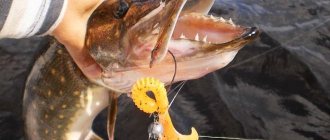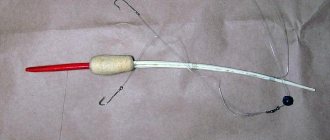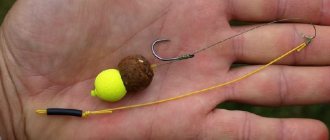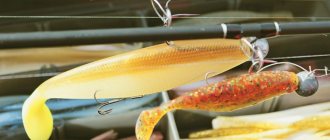Date: March 28, 2021 |
When a novice fisherman first purchases soft silicone baits , as a rule, he encounters installation difficulties. Indeed, in jig baits, silicone comes separately and somehow you need to attach sinkers and hooks to it. At best, the seller will offer jig heads (single hook combined with a weight) and show how to mount rubber on it. In reality, the practice of installing silicone is much wider, more varied and conceals a number of nuances. This review is dedicated to revealing these points.
Jig head mounting
The simplest installation available in fishing stores is a jig head. A lead ball, boot or other shape, poured onto a special single hook with a ring bent inward.
Jig heads come in different sizes and weights. The weight is selected based on fishing conditions: depth and presence of current. The hook number and its dimensions should depend on the specific bait. The jig head is a rigid rig. There is no freedom of movement between the weight and the hook. So the silicone will be constrained in movements. Therefore, the hook should not occupy the entire length of the snag, otherwise it will lose its attractive game. Active baits are usually attached to jigs: vibrating tails, twisters, some types of crayfish and cuttlefish with active play. Slugs, worms and other passive rubber are used less often. These lures don’t have their own game anyway, they have to be animated by the movements of the rod, so there is no need to be constrained with them.
For the vibrotail to play well, the hook should not go further than half of the bait. In some cases this is only the anterior third of the length. Twisters and vibrating tail models with chopped tails have understandable limitations dictated by their own shape. The hook should come out of the material in a thick place and not climb onto the thin tail.
On the other hand, you should not abuse the displacement of the hook towards the head. The less of the rubber band covers the tip, the more empty bites there will be. A reasonable balance is needed here.
Technically, there is nothing complicated about attaching silicone to a jig head. First, the hook is tried on from the outside. Apply the jig head, aligning the nose of the bait with the narrowing point, the point where the hook exits the weight. Having noticed the place where the hook should stick out, lightly prick it with a hook or put a dot with a marker so that it can be seen. The sting is inserted into the nose with silicone from the front end. Trying to maintain axial symmetry, push the elastic onto the hook. When the front part bends, hitting the bend of the hook, the moment is chosen to bring the tip out. In the case of a vibrating tail, it should come out in the middle of the back, near the intended point. All that remains is to seat the front end on the lead boss and straighten the entire structure. For small silicones, use jigs without a tide. This is fine. So the soft material does not tear as much.
You'll have to practice a couple of times. You may not fall into symmetry or guess the depth. With a little skill, everything will come back to normal, your installations will become normal.
There are situations when one jig head hook is not enough. The fish attacks, but the bite is sluggish and it’s impossible to detect. This can be seen especially clearly when fishing for pike. The toothy predator pulls off the silicone, cuts its edges with its teeth, but cannot swallow it or grab it by the hook. In this case, additional hooks are used. You need to attach a small double or triple hook so that it is closer to the tail, but does not hinder the play of the bait. There are several options here.
If there is still space behind the exit point of the jig head hook, then you can put a small tee on it by the ring. Stick one of the stings into the back, with a slight stretch. It turns out that the other two horns will be above the back to watch for a bite. Usually there is no need to fix the tee ring in any way. He's not going anywhere anyway. But some people pin a rubber bead on the main hook and press the ring with it, for aesthetics.
The second option is to take a double hook in order to install it down and back. Try it on from the outside to make sure the hook fits. From below, at an angle, they pierce the ring and push the hook so that the ring comes out in the back area, where the hook of the jig head is located. Having crushed the silicone, they ensure that the double’s ring sits on the main hook. They straighten everything out and get a double attached to the tackle, sticking out from the “ass” of the vibrotail.
You can install a double or triple hook on a swivel in the same way. Select a swivel of suitable length. If the body of the silicone is high, then you can use a triple swivel. Either the double is attached to the swivel directly, or the tee is hung through a small, neat winding ring. The swivel is pierced as described above and inserted with the upper ring behind the hook of the jig head. It turns out that the auxiliary hook will dangle freely from below. Of course, such additions increase the risk of getting caught on snags. But here you need to approach it carefully, because they also increase the chances of catching a fish.
The tee can also be installed on an additional leash without connecting it to the main hook of the jig head.
How to put a double on a silicone bait
Take, for example, a vibrating tail of the required size and a suitable double hook. We apply and mark the place where the hook tip should come out from the body of the bait.
We thread the double hook perpendicularly through the body of the vibrotail at the marked exit point.
Then you need to move the silicone to the head of the double. To ensure that the delicate rubber is not damaged, we slightly spread the shanks of the hooks and drag the bait through.
Having brought the bait to the base of the hook, we drown the double loop into the body of the vibrotail and put it on the fore-end with a stocking.
As a result, we get a bait dressed on a double.
There is an installation option where the silicone is simply inserted between the shanks of the hooks. I used it the first time, but somehow it didn’t catch on. And with such equipment, the baits last quite a long time, and it doesn’t take much time to put them on.
In this way, not only classic vibrotails are mounted, but also other silicones - twisters, worms, crustaceans and shrimps.
It happens that the body of the bait is made of a rather dense material and it is difficult to put the silicone bait on the double using the presented method. In such cases, in order not to further injure the rubber, before passing the base of the double, the body of the bait is pierced with an awl or nail. The created channel makes it easier for the hook to pass through.
When installing our bait through the winding ring, we must remember that the rings must be of the correct shape, namely with the edges placed in one plane and they should not overlap between them there must be a gap where the eye of the offset hook will be freely placed, because these two edges If they overlap in different planes, the degree of freedom of our hook will be significantly reduced or it may not move at all.
Hi all! Now we will consider the topic of how to choose a load for a jig. In order to understand what kind of weight we need in our conditions, we must understand what types of jig weights there are, what their pros and cons are, etc.
The first types of sinkers, rigid coupling with bait, include the classic jig head, corkscrew mounting with a tee in the back of the bait and a loaded offset hook, what does such a mounting give us? It gives us a rigid connection, which means that when your bait reaches the bottom it stops working; there are no residual vibrations because the weight does not allow it to move, this type of jig head looks something like this.
Tips for a fisherman: How to attach a silicone bait to a double - All the nuances
This method allows you to put on silicone 1-3 times, after which the bait will fall apart, so this type of cargo has become less in demand. Now jigs with a spiral have appeared, this allows you to attach the silicone well without damaging it too much; on such a jig head you can replant the bait 5-6 times.
In addition to standard jig heads, manufacturers make various custom unique things, such as a jig head combined with an offset hook.
There is also a combined offset machine with a bullet load; the shape allows you to pass very well through filamentous algae, through thickets of tarawa, and through various places with hooks.
There is also a very interesting rockfish series, these are dart jig heads, they look like the tip of a spear, in fact, when inserted, they allow you to behave like a wobbler, they yaw from side to side with a deviation of up to half a meter, this is if you use a cord or fluorocarbon.
Recently, it has become popular to make jig heads in which the angle of deviation of the attachment loop from the hook axis is 120 degrees; according to the manufacturer, having an angle of 120 degrees makes your hooking more effective, since the vector of the direction of your tip and the direction of the cord are almost in the same direction.
This type of sinker is like the non-collapsible Cheburashka that existed before until they came up with a collapsible one, it has the advantage that the fittings in it are rigidly fixed and this is very popular among trophy fish catchers since there is no way to unfasten this fittings and break them, we have the disadvantage of a longer time for mounting the bait, Since all installations are done through the winding ring, this additional time is an additional inconvenience.
When installing our bait through the winding ring, we must remember that the rings must be of the correct shape, namely with the edges placed in one plane and they should not overlap between them there must be a gap where the eye of the offset hook will be freely placed, because these two edges If they overlap in different planes, the degree of freedom of our hook will be significantly reduced or it may not move at all.
The collapsible Cheburashka eliminates these shortcomings; you can quickly change your bait, but these same qualities in pairs were not a plus because some manufacturers of sinkers made the reinforcement of the wrong shape and short length, and due to this it could simply slip out of the body of our sinker and could be annoying gathering of trophy fish.
A very original concept for mounting a winged jig, what is its specialty? Actually, the presence of a wing made of transparent plastic, this wing allows you to slow down the time the bait falls.
This type of installation as a jig grill has the ability to raise the head part of our bait to the bottom, this is useful when fishing on a shallow bottom, the fairly large freedom of our hook on the axis of our fastener has good flight properties and, in the case of installation on an offset hook, also has good cross-country ability. chains.
Passive types of silicone baits are animated by a rod and reel, so their equipment is attractive only on either spaced or hinged types of mounting; on hard jig heads, such baits catch the worst. This type of bait, such as crustaceans and other creatures, works better on hinges and spreaders; on rigid couplings they have very poor flight qualities.
And perhaps the most universal and good catcher on all types of rigs and plays well is a regular twister; it provokes our predator equally well on a hinge, on a jig head, and on a retractable leash.
The plastic keeper (final keeper) is even easier to install than the spring keeper.
Earlier, we said that in order to securely fix a soft silicone bait on an offset bait, a plastic retainer is required, which will not allow the bait to slide off the hook after idle bites, pulling through algae, etc.
In addition, fixing the bait prolongs its life, preventing it from breaking at the head attachment point. This is especially true when using soft rubber.
Stopper
It was proposed to use half of a cut float stopper as a retainer, as in the photo above.
I still think this is one of the most convenient methods, but it does have the downside that some of the stoppers break when threaded onto the hook.
Spring retainer
Another well-known method is to screw a spring corkscrew into the head of the bait, into the ring of which a hook is threaded.
Both of the methods described above are good, but thanks to the readers of the channel, several more were found. The most interesting, in my opinion, are described below.
Plastic retainer
The plastic keeper (final keeper) is even easier to install than the spring keeper.
Tips for fisherman: How to put silicone on a jig head - What to choose for fishing
Sequins
Sequins are discs with holes for decorating clothes and other products. To use as a fixative, you need to choose the smallest sequins with a diameter of 3-5 mm with a thin hole.
To fix the bait, the disk is threaded onto the hook, like half a stopper in the first method.
Hinged mounting
Hinged mounting works well with active and especially passive baits. The weight used is eared, the so-called “Cheburashka”. This is a ball with two rings. Previously, there were blind options, with rings firmly installed. The hook was attached directly to them (double), using a winding ring or a wire addition. Today, collapsible “Cheburashkas” have come into widespread use, which have rid the structure of unnecessary elements.
The idea of the hinge is to allow the hook and bait to dangle freely relative to the weight. This gives more freedom for silicone play. The rubber fit itself depends on the type of hook, which can be:
- single
- double
- triple
- offset
Hinged jig installation
Date: February 24, 2015 | 095
Beginning spinning anglers are faced with the question of how to mount their jig baits made of soft plastic or silicone. One of the main installations in microjig fishing is the hinge. The swivel hook and sinker connection is an excellent and most common mounting method. What kinds of hinged installations there are, what elements are used in them, what features they have - these are important questions and we’ll talk about this in detail.
Hinged mounting , today, is the connection of a collapsible eared sinker (the so-called “Cheburashka”) and a hook. Everything is very simple. And, most importantly, it is effective.
The sinker is collapsible. The wire bracket is removed and the hook is placed on it and the weight is reassembled. The hook can be used:
— Single with a large ring;
— Offset;
— Double hook;
- Tee.
Some kind of tackle consisting of several hooks can also be attached. This is especially in demand when installing large silicone baits.
In microjigging, the most popular rigs are those with single hooks with an enlarged ring, as well as those with offset hooks.
This installation gives the bait proper freedom relative to the sinker. The freedom of action of the bait makes its movements more natural and attractive to fish. This is especially true for passive silicone baits, for slugs, worms, crayfish, etc.
Let's compare it with what happened before, before the advent of collapsible eared sinkers.
Cheburashkas were rigidly cast. The hooks had to be attached either through winding rings, or through some kind of wire inserts, or by unbending the hook ring. Of course, collapsible weights are much more advanced and interesting. Their appearances were revolutionary and a very positive innovation.
A silicone bait is attached to the articulated hook. You can simply attach it to the tackle by tying it directly with a knot. You can knit tightly or loosely so that the weight dangles freely in the knot in the shape of a loop.
This method of fastening has one slippery point. The quality of the collapsible weight itself is important here. The wire bracket must be firmly held in the slot of the weight, otherwise, with some sharp jerk, when biting, the bracket may jump out and the bait will be lost in the water. I had this until I bought a series of better earflaps.
To protect yourself from this unpleasant phenomenon, you can fasten the installation using an American fastener. The clasp prevents the weight from moving out.
In addition, the presence of a fastener makes it possible to quickly change baits and change the weight of the weight.
If pike bites often occur, if the sections of the fishing line are worn out, then the mount is attached to a metal leash.
Let's look at the advantages and disadvantages of swivel mounting in comparison with another popular method of equipping silicone - with a jig head.
Advantages of hinged mounting:
— Increased degree of freedom of the bait and more natural play;
— The ability to better present the bait with positive buoyancy (on a hinge, it floats nicely above the bottom, better attracting fish);
— Wide possibility of varying weights of weights with hooks of different types and sizes;
— Longer casting range due to smaller windage (the bait flies after the weight).
Disadvantages of hinged mounting:
— Slightly more snagging installation (can be treated by using an offset hook in places with a large number of snags);
— Not very good compatibility with vibrotails;
— The quality of the hook is worse than that of a jig head;
— The cost of the hook-weight set is higher.
If we analyze the percentage ratio of the use of hinged mounting and jig heads in microjig, then the ratio will be 9 to 1, in favor of the hinge. This is due to better game, freedom of bait, improved range where it is critical. Also, this is due, trivially, to the fact that the vast majority of passive silicone baits that work best with a hinge. There are many types of them, many models. And the use of jig heads is limited to vibrating tails, partly twisters and a very small percentage of passive baits. So, the effectiveness and importance of hinged mounting in modern microjigging can hardly be overestimated.
Share with your friends:
Categories: Installations · Tags: Sinkers, Hooks, Microjig, Installation, Tackle
Micro jig joint with single hook
The combination of a swivel rig and a single hook is most often used in microjigging, with relatively small lures. For large silicones, it is preferable to use double and triple hooks.
Special hooks with an enlarged ring are used. You can also use regular ones, but try to choose ones so that the ring does not sit tightly on the sinker’s ears, but provides some freedom.
The classic landing on a single hook is no different from the story with a jig head. The tip of the hook is also measured and removed from the back so that it is parallel to the body of the bait.
You can make a landing with reduced grip. This technique is used in charged places. In essence, this is installation, like on an offset hook, only it is carried out on the regular version. The nose part of the silicone is pierced with a sting, at an angle, bringing the hook down. It is pulled all the way until the ring reaches the nose of the decoy. All that remains is to insert the tip of the hook into the abdomen from below and bring it out under the back. This trick works best with narrow-bodied silicones. They will give you space to press into when biting.
Methods for attaching silicone baits
Date: February 27, 2015 | 426
In addition to the correct choice of silicone bait, the way in which it is attached to the hooks and how it is mounted is also very important. Yes, choosing a shape, size, getting into a color that the fish now likes is all cool. But, it’s enough to assemble the rig incorrectly, attach the bait in the wrong way or on the wrong thing - and that’s it, you won’t see a catch, or it will be much scarcer than if we did everything correctly. So, it makes sense to talk specifically about different silicone baits, about edible bait and methods of its installation, attachment to hooks.
I’ll go through the main forms of baits and tell you which mounts and rigging methods are most suitable for them.
Vibrating tails are best attached to a jig head. On a rigid mounting, which is a jig head, the body of the vibrotail is clearly fixed and, when retrieved, has slight deviations along the trajectory. But the tail plays perfectly in relation to the body. It is this vibration of the tail that is the main attracting factor for the vibrotail.
Thin vibrating tails can be attached to a jig head in an unusual way, hiding the sting almost like in an offset hook. This is practiced in places where there are a lot of snags.
Vibrating tails can also be mounted on a hinged mounting with a single hook, and narrow vibrating tails are often used with offset hooks. However, in these cases you should be very careful in choosing the weight of the weight. Only over a short range of scales will the vibrating tail play normally. This is due to the vibrotail’s own freedom of movement of the body relative to the weight; and the tail, relative to the body, may not play as it should. So, if you are planning to mount a vibrating tail not on a jig head, check the specific bait model for the quality of the game with a specific weight of the weight.
Some narrow-bodied vibrotails, usually with a worm-like body, can also be used for such an unusual method of installation as “wacky”, when the bait is threaded with a hook somewhere in the middle and dangles at both ends.
Twisters work well on a wide variety of rigs. Perhaps the twister is the most unpretentious and versatile bait in terms of installation.
The twister can be mounted on a jig head or on a swivel mounting. Twisters go well with single, double, and offset hooks. Of course, the popularity of using a twister joint is somewhat higher than using a jig head.
Twisters mounted on a single or offset hook are very often used for fishing with a retractable leash.
Slugs , as a passive bait, are located more towards the hinged nozzle. You can, of course, use a jig head, but the body of the bait will have less mobility.
Slugs work great on a hinged rig with a single hook, when only a small part of the bait is occupied by it, and the majority plays freely and naturally (but with this rig, you should wait well between the start of the bite and the hook).
Also, many slugs are well adapted for installation with an offset hook, having a special slot on the back to hide its tip. However, slugs without such a feature can be attached and used with offset hooks just fine.
When a slug is mounted on an offset hook, there are many options for using it. You can put a rather heavy eared sinker and move the slug in sharp jumps, in steps, along the bottom. You can fish with a light weight, using a wide variety of, mostly smooth, movements in the retrieve. You can use a slug on an offset press using Texas equipment. And also, fish in the shallows without using a sinker at all. In addition, a slug on an offset bait is almost the most popular bait when fishing on a retractable leash.
Many narrow-bodied slugs are some of the best lures to use in the weckie style.
Silicone worms are used in many ways similar to slugs. Here, the most popular are hinged rigs with single or offset hooks and light weights so that the worm sinks as slowly as possible, naturally wriggling.
Worms are the most suitable type of bait for wacky style baits. So, some models of edible fish even have a specially sealed ring in the middle area to attach the hook there and keep it securely there.
This silicone worm, which plays attractively with its ends, attracts a wide variety of fish very well.
Silicone imitation crayfish are usually mounted with their claws backwards, so that there is a feeling of a real crayfish moving backwards, carried away by the fishing line. You can attach the crayfish to a jig head.
However, the game of silicone blende is revealed much better by hinged mounting. This can be a single or double hook.
And, if they are caught in places rich in snags, the crayfish is attached to an offset hook.
Despite the usual style of attachment, some models of crayfish can be attached, on the contrary, with the claws forward. This is especially true for models whose neck is weighted with salts.
Various cuttlefish and hybrids, strange silicone baits are very diverse. There are no uniform approaches to their installation. Look at the bait, which of the ones described above is most similar to it - then bait it.
Share with your friends:
Categories: Installations · Tags: Hooks, Installation, Silicone
Double hook rig
The double is hooked onto an eared sinker. It is noteworthy that this can be done without even disassembling the latter. Install it so that it is prying and looking in the opposite direction from the eccentric of the load, that is, up. For the purposes of such installation, you can find doubles with an extended forearm on sale. If the length is not enough, you can extend it with wire.
There are several ways to create a double in silicone. You can push the ring from the middle and bring the ring out through the nose of the blende. A more correct option: pierce with one hook, wind the hook to the ring and only then pierce.
Installation of silicone baits on a tee
There are two main ways to install a tee into a vibrating tail. The first option involves the use of a special sinker with a spiral lock resembling a corkscrew. A treble hook is attached to the front ring, complete with a wire extension. The nose part of the bait is screwed onto the clamp. When the end reaches the weight, one of the hooks of the tee is stuck into the silicone. The other two remain outside. Installation is ready.
The second method is practiced mainly with vibrating tails. In the place where the tee should be located, or rather the place where its hooks diverge, a small through hole is punched. This is done with a thin-walled metal tube with a diameter of 4–6 mm, perhaps empty pen paste or something similar. A wire extension is attached to the tee ring. The wire is inserted from the hole to the nose of the silicone. One of the hooks is inserted into the hole and brought out on the other side of the bait. The sting of the second horn is inserted into the hole and removed through the back. The wire is twisted into a ring, thereby securing the installation from the front. It turns out very neatly and reliably, and three hooks provide maximum correct hooks.
Installation of silicone baits on double hooks
We place the bait in the left hand so that its head is facing away from us, and we turn the hook with a bend towards the body of the bait. Then we look at the distance at which the hook tip should come out (in the center of the bait’s body). We place the double so that the left hook points in the direction of the head of the bait, and with the right hook we pierce it through the center and bring it to the eye of the double. We unfold it and make sure that the forend of the double is clearly aligned with the axis of the bait, and push it into the body of the bait, so that the double ring comes out exactly along the axis.
On an offset hook
Options for equipping silicone with offset hooks are very popular. They provide a reduction in snagging on underwater obstacles, which reduces the loss of baits.
Narrow-bodied baits are best combined with offset baits:
- worms
- slugs
- twisters
- crayfish
- vibrotails with a worm-shaped or narrow body
High-bodied vibrotails can also be adapted, but they will have to be placed flat, turned 90 degrees, relative to the classic position.
The offset hook pierces the front, from the nose ridge and down, at an angle. The hook is pulled through, and the step located at the ring should take its correct position. All that remains is to try it on and pierce the belly of the decoy with a sting in the right place. The tip is brought out and installed closely, without rising above the level of the material. Many modern silicones have special longitudinal slots where the offset press tip is removed and masked. A very smart and thoughtful move!
Offset hooks are paired with eared split weights or a Texas-rigged bullet weight. They are also widely used in various spaced installations, such as:
- drop shot
- diverter leash
- Carolina rig
On a single over the edge
Silicone decoys can be attached to a single hook not only in the classic way, with a stocking. Often it is necessary to provide silicone with more freedom of movement. Then they go to fix it at the very edge. Either they hook the bait from below, or they insert the sting into the nose, but remove it soon, without hiding the entire shank of the hook. Of course there will be misses and empty bites. But the number of bites themselves may be noticeably greater if the fish is passive and reacts poorly to the classics.

